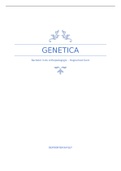Samenvatting
Samenvatting - Applied Animal Ecology (WEC20803)
- Instelling
- Wageningen University (WUR)
Een volledige samenvatting van alle lectures met bijbehorende graphical abstracts van het vak Applied animal ecology aan de WUR. De samenvatting is volledig in Engels, met enkele lastige woorden cursief in het Nederlands vertaald. Met de samenvatting heb ik een ruime voldoende weten te halen.
[Meer zien]







